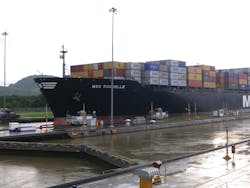‘Latin America Has Great Potential’: Expo Brings Global Tire Industry to Panama
Tire World of North Carolina LLC is looking to expand its wholesale used tire business. Mick Smith and Martin Gabalda already sell bundles of hundreds of tires in North Carolina, Virginia and Tennessee. It’s only natural their next market would be — Latin America.
Actually, it’s not an entirely new world for Tire World. The Greensboro, N.C.-based company used to ship used truck tires to dealers in the region, but low-cost imports interrupted those sales. It’s hard to sell used tires, even if they’re from top-tier manufacturers, when new low tier tires cost less, the men said. But they see a new market, so the company is trying Latin America again, and Smith and Gabalda set up a booth at the seventh Latin American & Caribbean Tyre Expo in Panama City to meet potential customers.
“They’re looking for light truck tires here, 16-, 17- and 18-inches,” Gabalda said as he and Smith greeted visitors to their booth.
They’re certainly not the only ones testing the market. “We might as well get down here,” said Mike Levenda, a sales manager for Alligator North America Inc. He and Blendi Bega were showing the company’s lineup of tire valves and tire pressure monitoring systems (TPMS). And they were a bit surprised by all the interest in TPMS for trucks.
- Krishnaram, CEO of Emrald Resilient Tyre Manufacturers Pvt. Ltd. in India, returned to the show for the first time in five years. The industrial tire company has sales offices in Belgium and Dubai, and wants to expand to the U.S. as well as Latin America. Krishnaram said he’d like to open offices in Atlanta, Ga., as well as either Panama or Peru. Among Emrald tires’ applications are at sea ports and on airplanes, he said.
“Latin America has great potential. Latin America needs a quality supplier. They’ve been infested with cheap products.”
He said dealers were asking different questions during the July 2016 show than they had previously. They used to ask about price first. This year, price wasn’t even part of the conversation. “I feel this market has great potential for a product like ours.”
Comments like those support the work Gus Lima has done to build this show over the past seven years. Lima is CEO of Latin Expo Group LLC. Committed to keeping this expo focused on tires, he hasn’t allowed auto parts suppliers to set up shop. Instead, he’s added a separate expo for them. The Latin Auto Parts Expo was held in the same convention center a month before the tire expo.
“Latin America is a good place to do business,” said Lima. “There’s a need. Everyone who walks through the door has been vetted as a tire dealer or a company that deals in tires, such as construction with a lot of equipment. We call them. We don’t just look at the internet. We have a team in Miami that does the vetting.
“A lot of people tell me ‘at SEMA there are 106,000 people.’ But how many are going to buy tires? Does anybody know? I know everybody that comes here, whether it’s 2,000 people, they came here to buy tires. We don’t give caps away.”
The International Trade Administration (ITA), part of the U.S. Department of Commerce, backs up Lima’s optimistic outlook for the region. The ITA is working to attract more U.S. businesses to export to Latin America. As part of its “Look South” initiative, the ITA has identified 27 sectors of industry that would be especially attractive to U.S. exporters. For the automotive parts and supplies sector, nine countries are identified as specific market targets: Chile, Colombia, Costa Rica, Dominican Republic, El Salvador, Guatemala, Honduras, Mexico and Panama.
Of those nine countries, seven list tires among the best prospects for more business. Costa Rica and Mexico are the only ones to leave tires off their lists. Mexico is home to a growing number of tire manufacturers, the ITA doesn’t list any specific targets for Costa Rica. It noted though that Costa Rica’s exports, which totaled $160 million in 2015 and are expected to be about $155 million for the next three years, “are mainly due to the local Bridgestone plant that expanded production and exports all over the world.”
Colombia is a prime market for consumer tires, as well as truck and bus tires, tire retreading equipment and tire recycling operations. Guatemala is in need of wheels and tires, plus service equipment for tire repairs and tire balancing, plus lifts.
Elgi Rubber Co. LLC is among those battling for a piece of the equipment market. Ron Mohler, commercial development manager for North American markets, was part of a team of employees in Panama. The company’s Jet brand of tire retreading and repair systems was on display, and Mohler said he sees room for growth as recycling is an emerging concept in some countries. The goal was to present the company as a comprehensive supplier of the “equipment, tools and consumables that (dealers) use daily in the process.”
New hope for retreaders
Retreading was a big topic at the expo, and not just on the show floor. In a series of forums industry leaders talked with hope about a turnaround. Low truck tire prices have created a crisis for retreaders in Latin America, but industry leaders see signs of a rebound, and believe the worst is behind them.
Heriberto Romero, general director of Hules Banda S.A. de C.V., told attendees, “We’ve already reached rock bottom. We do feel there is a slight uptick. The numbers don’t lie. We’re seeing volume that is trending upward.”
And though that’s welcome relief, Romero also pointed to plenty of opportunity for retreaders to expand their reach in Latin America. Eighty percent of fleets are operated and managed by individual truck drivers, and only 20% are handled by large fleet companies.
Large fleet operators already are monitoring their mileage and tire wear, according to Romero. That is something individual drivers have yet to put into practice, which means there’s also a big opportunity for retreaders to be part of a more economical, long-term solution.
“We’re going through a crisis right now. Crisis also means opportunity. How do I do more with what I already do?”
Romero said one option is to look beyond the tires for more sales. In his business, he turned to selling lubricants. Truck service, shocks, batteries and alignments are all additional selling opportunities. “We need to have a bigger portfolio.” And a dealer’s existing sales staff can handle an expanded portfolio without requiring a salary increase, he said.
Jean Alexander Barros, Vipal Rubber Corp.’s coordinator of commercial products in Mexico and Central America, also believes retreading is on its way back in the region.
Barros said dealers need to teach this lesson: “Cheap ends up expensive.”
About the Author
Joy Kopcha
Managing Editor
Joy Kopcha joined Modern Tire Dealer and Auto Service Professional as senior editor in 2014 after working as a newspaper reporter for a dozen years in Kansas, Indiana and Pennsylvania. She was named managing editor of MTD and ASP in 2022, and took on that same role with Motor Age in 2024.
She is an award-winning journalist, including in 2023 when she was named a Jesse H. Neal Awards Finalist.
Don't miss any of her articles. Sign up for MTD's newsletters.

